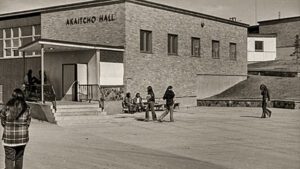The first public meeting on using the former Akaitcho Hall location for a new Art Centre was held Tuesday night in Yellowknife.
The meeting was held at the Tree of Peace Friendship Centre, and was attended by many community members who engaged in a thoughtful, nuanced and, at times, emotional conversation.
Among the participants were former residents of Akaitcho Hall, as well as survivors of other residential schools, many of whom shared their experiences for the discussion, both positive and negative.
Gwich’in historian, Dr. Crystal Fraser, says most people were really supportive of the idea of the Art Centre in that location, beside the modern Sir John Franklin Hugh School on 52nd Avenue.
“There were many ideas exchanged, including having a collage wall inside the Art Centre, which can feature Akaitcho Hall,” she said. “There were talks about a research centre within the building that could really share Akaitcho Hall’s history and the history of residential schools more largely in the North.”

Students outside of Akaitcho Hall in Yellowknife in 1973. (NWT Archives/Native Press)
Other ideas that were explored included the additional use of the location as an education centre, where it could help to undo the harmful effects of residential schools.
Said Fraser: “There was also a really profound idea that the former site needs to be blessed in a certain way that would ensure that the new Art Centre building could do all of its work in a good way. So the acknowledgement that there were former students who passed away at Akaitcho Hall, and there were other things that happened that are really hard histories.”
Fraser added that Akaitcho Hall has a more complicated legacy within the community compared to other residential schools. She explained that, as demonstrated at the meeting, there are former residents of Akaitcho Hall who speak about the building in a positive light, and have pleasant memories associated with their time there.
The Hall held unique status among residential schools in that it was built in the 1950’s, and was part of a larger, post-war federal project to attempt to bring schooling opportunities to Indigenous children in a time when there were many discussions taking place regarding Arctic sovereignty.
“And so the reason I’m saying this is because these institutions were extremely well funded, so they did not run like former residential schools, which, to be frank, often depended on child labour in order to operate.
“There was this larger socio-economic political context that the large hostels were under much more scrutiny. They were a part of the public narrative, they were located right in the centre of urban spaces, which allowed for more oversight. The rules had to be followed. If there were any kind of extreme conditions at a former residential school, we didn’t necessarily see that at these big institutions.”
Fraser adds that Akaitcho Hall had an incredibly diverse body of residents, including Indigenous, settler, and even Chinese newcomers to Canada. This larger population meant that there was a larger amount of parental involvement.
Despite these differences, however, the National Centre for Truth and Reconciliation does list four students who passed away due to their experience at Akaitcho Hall. Dianne Bourne, Georgoe Novoligak, Philip Mitchell, and Thaddeus Leonard.
Fraser also mentioned that, as with any other residential school, there are likely individuals who do not yet feel strong enough to come forward and share their experience.
A second meeting for the Akaitcho Hall Art Centre discussion will be taking place next week, on Wednesday, June 25th. The meeting will be held virtually at 7pm, the link to which can be found on the NWT Art Centre Initiative website.





